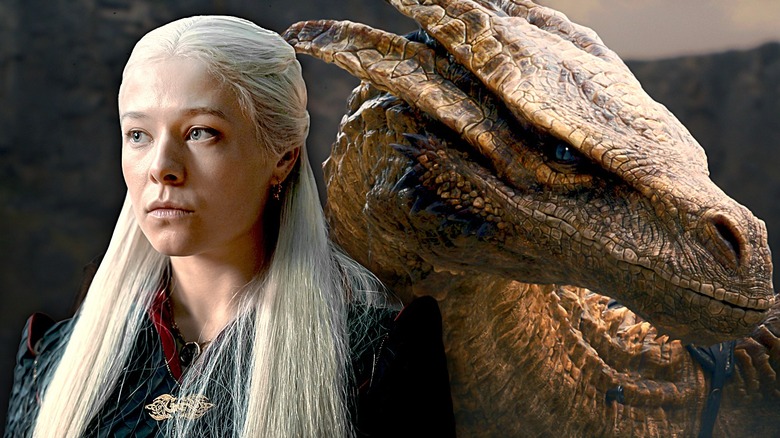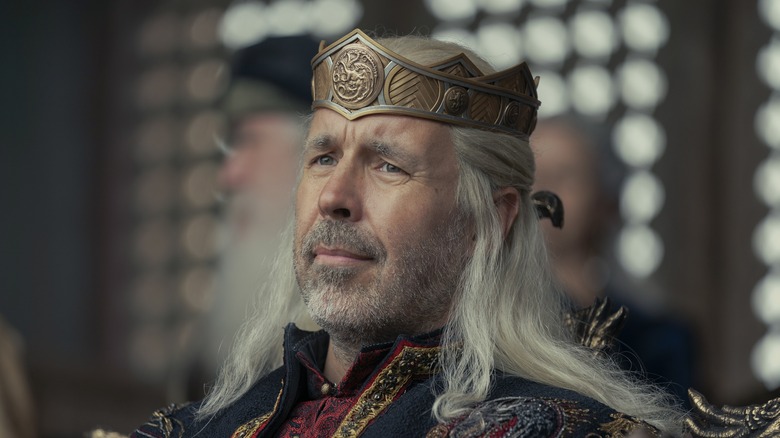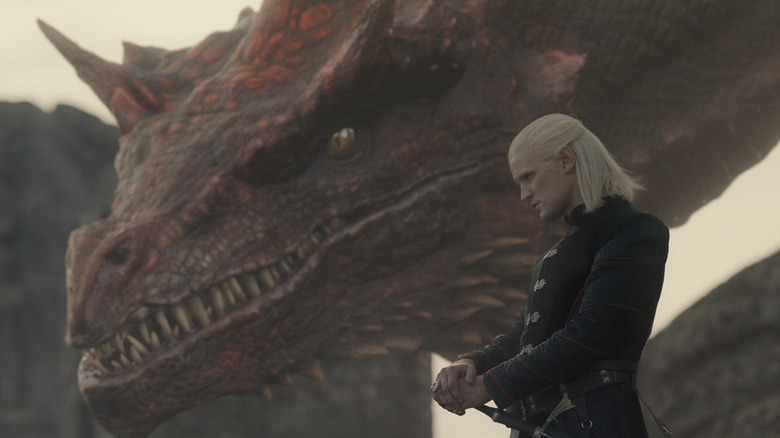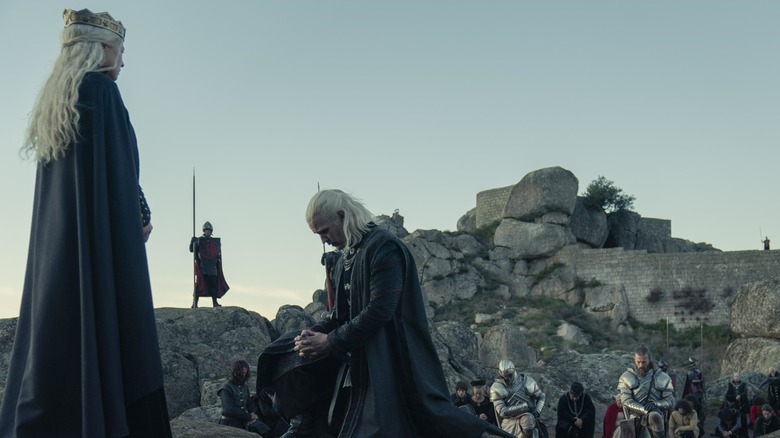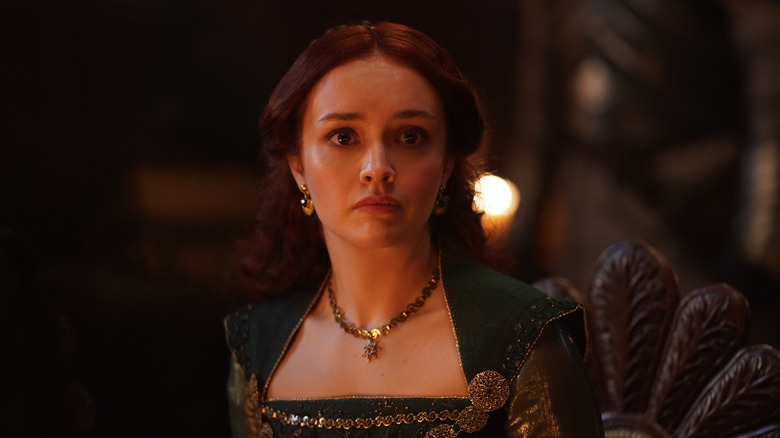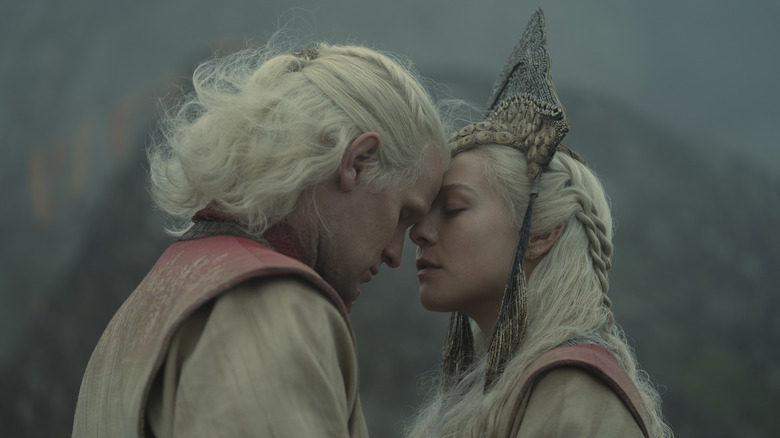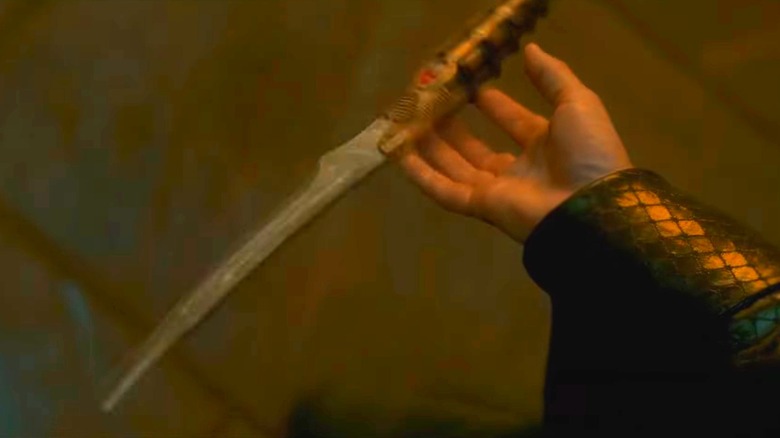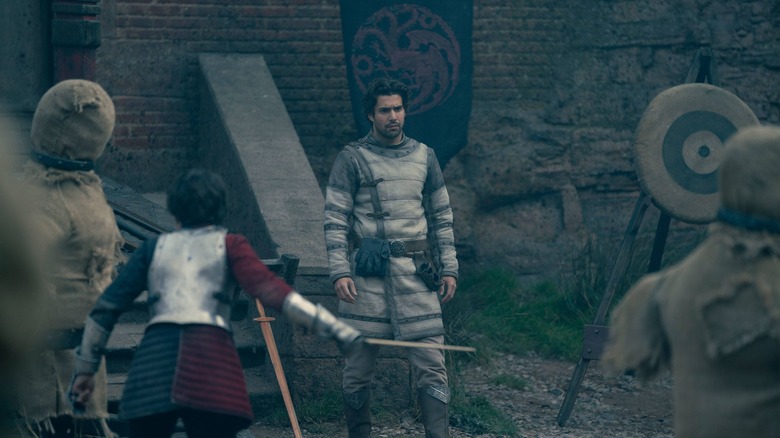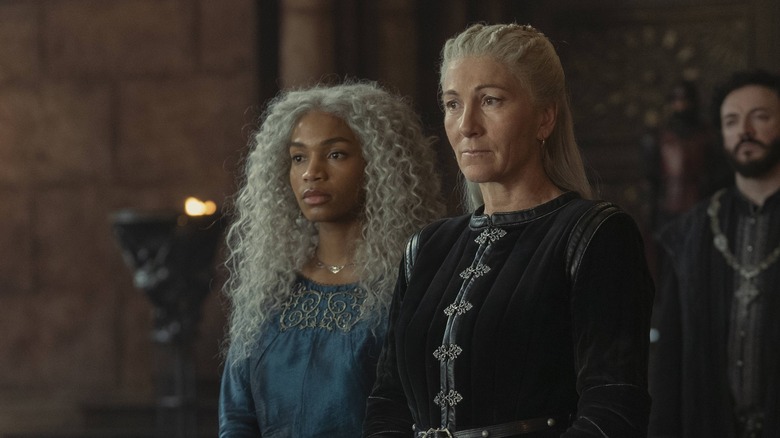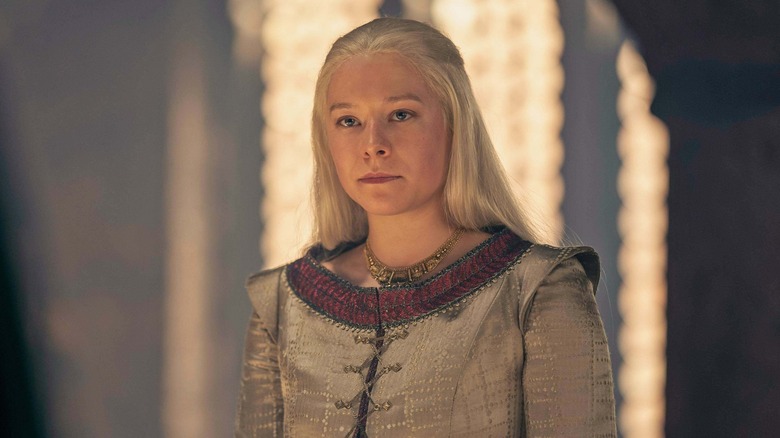Mistakes That Are Hard To Ignore In House Of The Dragon
Making a TV show is hard, especially when it's a high-profile fantasy series with a massive budget like "House of the Dragon." After "Game of Thrones" ruled for a decade as the biggest show ever made, expectations were sky-high for HBO's House Targaryen-centric prequel. With that many eyes checking out the new show, it was inevitable that viewers would catch at least a few mistakes. After all, when you have that many people working on a single production, certain details are sure to slip through the cracks from time to time.
To its credit, "House of the Dragon" has been pretty tight and clean when it comes to continuity errors and visual gags. The CGI has been impressive, the writing is crisp, and the drama stays tense. However, even the most prestigious productions miss things. These lapses lead to mistakes, no matter how small, which viewers often catch once things make it to the screen.
With "House of the Dragon" Season 2 looming on the horizon like a giant flying lizard, we're looking back at some of the most glaring errors in the HBO series so far. From CGI lapses and continuity drops to storylines that just don't make any sense, these are the hardest mistakes to ignore in "House of the Dragon."
The king with the green fingers
If we're going to list egregious continuity errors and production mistakes in "House of the Dragon," then we should probably start with the most infamous one. Early in the show, it's obvious that King Viserys I Targaryen (Paddy Considine) is in poor health, and he's rapidly getting worse. The cuts he keeps getting from the Iron Throne turn into grotesque scabs, and by Episode 3, most of his left hand is fully decaying. You can see in certain shots that some of his fingers are practically crumbling away, but when the episode first premiered on HBO, one shot notably forgot to include that detail.
Not the green screen glove on Viserys's missing fingers 🤣🤦🏻♀️#hotd pic.twitter.com/4CLUw5tDhI
— Sarah Capps (@SarahC_814) September 5, 2022
As pointed out by many viewers at the time, one moment in which Viserys hands a letter to a messenger failed to include the CGI coat of paint on his fingers. Instead, you could see the King's fingers covered in green, waiting for a post-production transformation to add in the gross details.
The error quickly drew comparisons to the notorious Starbucks coffee cup blooper in Season 8 of "Game of Thrones," though neither were terribly intrusive mistakes. Even so, HBO was quick to jump on the problem and do some damage control. In a matter of days, the error had been fixed on streaming, with Viserys' fingers gaining the appropriate rot. If you watch the episode today, you won't be able to see the mistake, but there's still ample documentation of it across the Internet.
The dragon rules are inconsistent
One of the more confusing things about "House of the Dragon" are the rules that dictate how the dragons themselves behave. While it's easy to get swept up in the fantastical majesty of these creatures while watching, you may realize after the fact that you're not actually sure how the dragon rules work.
One big example of this is the Dragonkeepers, who run the dragonpit and care for its scaled denizens while the riders are away. These wranglers are shown multiple times working with and commanding the dragons. However, elsewhere in the show, we're told that dragons only obey their riders once they have one. The Dragonkeepers are seen working with ridered dragons, including Syrax, so the answer is probably that these dragons remain somewhat open to suggestion and basic commands but would never let anyone other than their own rider climb atop them. Still, the show doesn't explain this outright, so the truth remains a little confusing.
Another major question concerns Seasmoke, the dragon of Laenor Velaryon (John Macmillan). Laenor fakes his own death in "House of the Dragon" Season 1 and runs away with his lover, leaving Seasmoke behind. This doesn't happen in the book on which the series is based, George R. R. Martin's "Fire and Blood," where Seasmoke is eventually claimed by another rider. Daemon (Matt Smith) also counts him among their side's rideable dragons at the end of "House of the Dragon" Season 1. If the show follows the book, it could run into some contradictions, as Seasmoke should know that his original rider is still alive ... right?
Rhaenyra isn't actually the Queen of the Rhoynar
Every moment in "House of the Dragon" Season 1 builds up to Rhaenyra's (Emma D'Arcy) coronation and the beginning of the Dance of the Dragons civil war. When she finally steps into her war room at the end of the season, crown atop her head, the payoff hits. Daemon introduces her using the traditional words for the ruler of the Westeros: "Queen of the Andals, the Rhoynar, and the First Men." However, the second part of that title isn't really appropriate in this instance.
The Rhoynar are one of the main ethnic groups in the world of "A Song of Ice and Fire," and the Rhoynar bloodline is primarily represented in Dorne, while the Andal genealogy dominates central Westeros and the remnants of the First Men are mainly seen in the North. At the point in the timeline when the Dance of the Dragons takes place, though, Dorne is still unconquered by the Targaryen dynasty. Despite attempts, the desert wastes of the continent's southernmost region and the tenacity of its people have prevented the dragon lords from actually bringing Dorne into their domain.
It's possible that the inclusion of the Rhoynar in Rhaenyra's title is just a form of posturing from the Targaryens — a claim to territory they don't actually control. Still, it's a bit odd. There's also a chance that this inclusion was an intentional response to a frequent criticism of the original show, which oddly left out the Rhoynar part of the monarch's title.
Alicent's favor disappears
The easiest place for continuity errors to rear their ugly heads on television is often in the editing room. When you're dealing with so many different takes, plus the demands of post-production, some small mistakes are inevitable. One such faux pas occurs very early in the first episode of "House of the Dragon," during the jousting match between Ser Criston Cole and Prince Daemon Targaryen.
Prior to the match, Daemon asks Lady Alicent Hightower (Emily Carey) for her favor, which she grants him, sliding the flowered wreath onto his lance. When Daemon lines up on his side of the field, you can see the wreath sitting neatly at the base of the weapon. However, after a quick cut to Cole (Fabien Frankel) on his own horse, Alicent's favor briefly vanishes, only to reappear later. In the shot where Daemon's horse rears, his lance is very visibly naked.
It's a small thing — the kind of mistake that's bound to happen on set from time to time. Perhaps the crew removed the wreath while filming with the horse for some reason, or maybe the scene was shot out of sequence. Whatever the explanation, it's a bit baffling once you notice it, but it certainly doesn't impair the drama of the duel.
That one romance is a bit too romantic
This one might not technically be a "mistake," but it's certainly a faux pas. Throughout "House of the Dragon" Season 1, Rhaenyra and Daemon's complicated, grotesque, messed-up relationship remains a central focus. "Game of Thrones" had its share of incest, sure, but it was always painted with a firm brush of toxicity (at least until that bizarre finale). No one in their right mind would ever root for Jaime and Cersei Lannister to figure things out. The same can't be said of "House of the Dragon," though.
For the most part, there's a healthy level of narrative distance and moral judgment attached to Rhaenyra's fixation with her uncle. He himself is shown to be a deeply duplicitous and egotistical man. And yet, when they consummate their relationship in Season 1, Episode 7, "Driftmark," the whole thing is shot like some grand climax. Their love scene is choreographed intimately, and the writing goes to great lengths to make the power dynamic between them feels balanced, despite the fact that Daemon tried to seduce her when she was a child.
Later episodes return to a more complex portrait of their relationship, but this particular scene is baffling in its intimacy. Perhaps the intention was to show how Rhaenyra feels in the moment, but it comes off like the series itself is endorsing the marriage between uncle and niece. In a word, gross.
There's no blood on Alicent's dagger
Another small continuity mistake occurs in "House of the Dragon" Season 1, Episode 7 during the tense confrontation between Rhaenyra and Alicent. Prince Aemond's (Ewan Mitchell) claim to the massive dragon Vhagar leads to a standoff between Alicent's children and Rhaenyra's, resulting in Aemond losing an eye. Alicent demands satisfaction in equal measure and threatens the children with a knife.
In the commotion, she ends up slicing Rhaenyra's arm, drawing a significant amount of blood, though the wound itself is relatively minor. Stricken by her own violent act, Alicent drops the dagger in dramatic slow motion. As it falls, it's easy to see that the blade is completely clean — not a drop of blood to be seen.
Like the strange vanishing of Alicent's favor in Episode 1, this is a small, easily forgivable mistake. However, given the dramatic focus of the shot in which the dagger falls to the ground, it seems odd that such an obvious mistake would have slipped through. The only feasible in-universe explanation would be that the strike is so swift that the dagger cuts Rhaenyra's flesh without drawing a single drop of blood. Highly unlikely? Yes. But possible? Sure.
How is Ser Criston Cole still around?
In a show full of morally ambiguous and downright repugnant characters, Ser Krispy Kreme may be the most detestable of them all. His position as a more lowly knight is sympathetic at first, and you might even catch yourself rooting for him early on as he rises through the ranks. However, he quickly takes a turn for the worse with repeated displays of rage, selfishness, entitlement, and brutal violence.
The climax of his dark descent occurs in "House of the Dragon" Season 1, Episode 5 when he murders Laenor's lover Ser Joffrey (Solly McLeod) in cold blood at Rhaenyra's betrothal celebration. It's a brutal and despicable act, and Criston very nearly takes his own life afterward, only to be stopped by Alicent. The next episode jumps 10 years into the future, where we see that Ser Criston remains a stalwart member of the Kingsguard. Why would Ser Criston be trusted to continue serving the royal family?
Series co-creator Ryan Condal offered an explanation to EW in 2022, saying, "Alicent goes in there and saves his life and begs for his life and honor with the king and wins. And then he is absolutely, as we see in Episode 6, 100 percent devoted to her." While this technically explains why Ser Criston is still around, the show skips over all the messy bits of his supposed redemption. As it stands, Criston's continued high standing still feels like it needs a bit more justification on screen.
Rhaenys' King's Landing escape has a small continuity error
This one's almost too small to include here, but as Cassian Andor once said, if we're making a list, we're making a list. One of the best episodes of "House of the Dragon" Season 1 is Episode 9, "The Green Council." It also features one of the biggest differences between "House of the Dragon" and "Fire and Blood" — Princess Rhaenys' dramatic exit from the Dragonpit atop her faithful mount, Meleys. Though she chooses to leave Alicent Hightower and the other Greens alive, Rhaenys has a golden opportunity to wipe them out with one swift blast of dragonfire. Instead, she simply flies away.
In the shot where Meleys takes flight, her legs lurch forward, as if she's diving at some invisible prey. In the next shot, which shows the dragon emerging into the open air, her legs are in the opposite position, pressed back against her tail by the sheer momentum. The two shots take place milliseconds apart, so there really isn't enough time for Meleys to change her posture so dramatically. This is the kind of detail that's easy to miss your first time through, but you may notice it after rewatching "House of the Dragon" Season 1.
The whole Targaryen prophecy is wrong
Perhaps the biggest hole in "House of the Dragon" is the Targaryen Prophecy itself, also known as Aegon's Dream or the Song of Ice and Fire. Early on, when he appoints Rhaenyra as his heir, King Viserys I reveals a huge family secret to her. He says that the entire reason Aegon Targaryen conquered Westeros was because of a vision he had — a premonition of darkness and evil descending upon the world, which would take a united kingdom to fight off. Aegon inscribed this prophecy onto a Valyrian steel dagger, and the story was passed from king to king.
This prophecy — the idea that a Targaryen must sit on the Iron Throne in order to protect the realm from the White Walkers — is a big part of why Rhaneyra insists on fighting for control of the Throne. It drives a huge part of the story and is treated by the show like a righteous cause. However, if you've seen the extremely disappointing "Game of Thrones" Season 8, you'll know that the prophecy doesn't play out anything like what Aegon believed it would.
Neither Jon Snow nor Daenerys Targaryen defeat the Night King to save the realm. Both fight the White Walker army at the Battle of Winterfell, but it's Arya Stark who uses Aegon's dagger to deliver the killing blow. This effectively undoes the whole point of the prophecy, making Rhaenyra's dedication to it feel more foolish than heroic. It's a huge hole in the story of "House of the Dragon" — though the show manages to rise above it.
If you or anyone you know has been a victim of sexual assault, is struggling or is in crisis, contact the relevant resources below:
- Visit the Rape, Abuse & Incest National Network website or contact RAINN's National Helpline at 1-800-656-HOPE (4673).
- Call or text 988 or chat 988lifeline.org
